Since January, GWLAP citizen science volunteers have recorded bats on over 30 different nights using Anabat bat detectors. On any given night there were up to four Anabat recorders at work in different locations.
Anabat detectors record the ecolocation calls of microbats (insect eating bats) and convert these calls to sonographs. Bats can be identified by the shape and pitch of call pictured on the sonograph.
Sonograph of a Southern forest bat:

Each night of recordings has been analysed for the bat species present and the data has been uploaded to the Natural Resources SAMDB bat portal hosted on the Atlas of Living Australia.
Monitoring results from all over the SA Murray-Darling Basin are uploaded to this portal and the results are publicly available.One good quality call from each species recorded at each location for each night was uploaded. A total 248 bat calls were logged onto the Atlas of Living Australia Bat Portal (listed below) from our area alone.
| Bat species* | Number of nights bat species was found to be present |
| Autronomus australis – White-striped free-tailed bat | 45 |
| Chalinolobus gouldii – Gould’s wattled bat | 42 |
| Mormopterus planiceps – Southern free-tailed bat | 41 |
| Vespadelus regulus – Southern forest bat | 36 |
| Nyctophilus geoffroyi – Lesser long-eared bat | 25 |
| Vespadelus vulturnus – Little forest bat | 22 |
| Vespadelus darlingtoni – Large forest bat | 4 |
| Chalinolobus picatus – Little pied bat | 3 |
| Chalinolobus morio – Chocolate wattled bat | 2 |
| Myotis macrocarpus – Large-footed bat | 2 |
| Nyctophilis corbeni – Corben’s long-eared bat | 1 |
| Scotorepens balstoni – Inland broad-nosed bat | 1 |
| Unidentified microbat | 24 |
*These calls are yet to be checked by a proper bat expert, but from feedback so far it seems we are on the right track.
Locations where bat calls were recorded:

It is not possible to determine how many bats are flying around on any given night from the calls recorded on an Anabat detector, but at least we know what species are around.
GWLAP would like to thank everyone who has been involved this season and look forward to getting back into bat monitoring when the weather warms up again.
This project is supported by the SA Murray-Darling Basin Natural Resources Management Board through funding from the Australian Government’s National Landcare Programme and the NRM levy.




